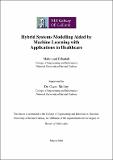| dc.description.abstract | Recent trends towards data-driven methods may require a substantial rethinking of the process of developing simulation models. For instance, Machine Learning (ML) has demonstrated great potentials for constructing new knowledge, or improving already established knowledge. Reflecting this trend, the study lends support to the discussion of why and how ML should support the practice of Modelling and Simulation.
Subsequently, the study proposes a hybrid approach towards integrating simulation models with ML. At its core, the approach is based on the premise that system knowledge can be captured and learned in an automated manner aided by ML models. The key idea is to realise ML-guided simulations during different stages of model development.
The study goes through a use case in relation to healthcare, which aims to provide a practical perspective for integrating simulation models with data-driven insights learned by ML models. Through realistic scenarios, the study utilises unsupervised and supervised ML techniques in order to demonstrate the practicality of the approach. First, unsupervised ML (e.g. clustering and rule mining) was utilised in an attempt to discover underlying structures or patterns within patient records. The knowledge discovered represented data-driven insights used to learn about the actual system. In this manner, the data-driven insights helped shape the structure and behaviour of the simulation model. Second, simulation experiments were conducted with the guidance of ML models trained to make predictions on the system behaviour.
From a practical standpoint, it was also aimed to deliver useful insights in relation to healthcare planning in Ireland, with a particular focus on the hip-fracture care scheme. The insights were provided based on a set of simulation models along with ML predictions. At the population level, simulation models were used to mimic the flow of patients, and the care journey, while ML provided accurate predictions of care outcomes at the patient level.
In a broader sense, the study aimed to make the case that simulation models can be integrated with data-driven knowledge learned by ML. In this respect, the integration of simulations and ML can allow for addressing further complex questions and scenarios of analytics. It is believed that the present work contributes in this direction. Recognizing its current limitations, the study can serve as a kernel towards promoting further integration of the practice of Modelling and Simulation with ML. | en_IE |


